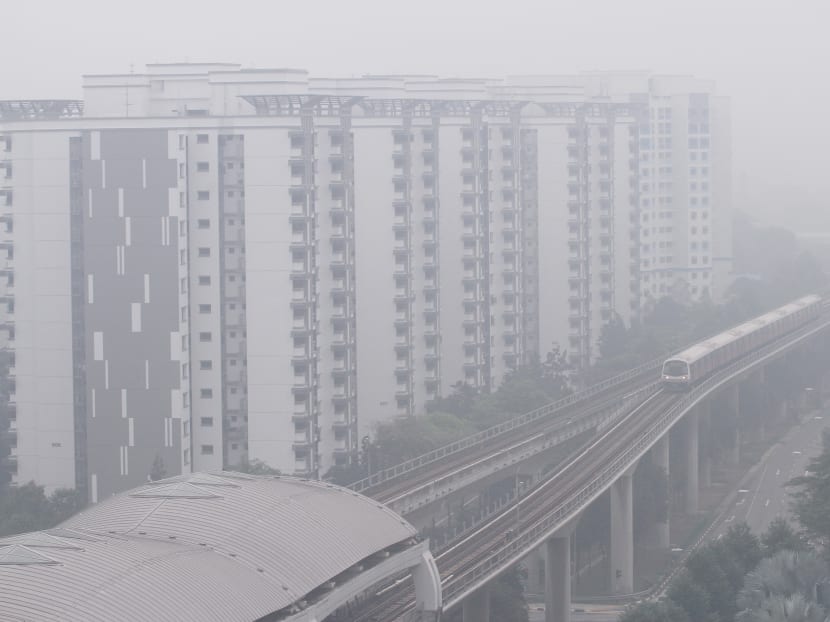NEA explains why it does not give hourly PSI readings
SINGAPORE — Poor visibility during haze episodes is not always caused by air pollutants, the authorities said today (Oct 8).
SINGAPORE — Poor visibility during haze episodes is not always caused by air pollutants, the authorities said today (Oct 8).
Questions about the accuracy of Pollutant Standards Index (PSI) readings and Singapore’s reporting of air quality have persisted and the National Environment Agency (NEA) held a media briefing today to tackle some of these.
There is poor visibility when PSI levels are high, but “poor visibility can sometimes be things other than PSI”, said Dr Felicia Shaw, director of risk and resource at the Meteorological Service Singapore (Met Service).
In the face of calls for one-hour PSI readings, Ms Indrani Rajaram, project director and chief scientific officer of NEA’s pollution control department, reiterated that the public should instead be using the raw one-hour PM2.5 data for various areas of the island as a gauge to take the “necessary action”.
“If tomorrow there’s a health study, a very rigorous health study, that comes out and tells us one-hour PM2.5 concentration is harmful, we’ll use that to do a conversion (to get one-hour PSI). But at the moment the studies out there don’t give you a number that is supported by health studies to do this computing,” she said.
PM2.5 is fine particulate matter that is the pollutant of concern during the haze. Moisture is among the factors affecting visibility, as water droplets scatter light and some smoke particles attract water molecules around them, Dr Shaw explained.
Sulphates — one such water-attracting pollutant — could also lead to deterioration in visibility, and a theory is that particulate matter from the forest fires in Indonesia is rich in sulphates because the biomass has been exposed to volcanic sulphur dioxide.
The Met Service charted the relationship between visibility, PM2.5 and relative humidity for the past month and found that visibility remained poor when PM2.5 levels are lower, so long as conditions were humid. Charts of 2013 and 2014 haze months also show that the thickest haze produces the worst visibility but this was coupled with dry conditions when relative humidity was below 80 per cent.
To calculate the 24-hour PSI, concentrations of each PSI component — sulphur dioxide, oxides of nitrogen, carbon monoxide, ozone and particulate matter (PM10 and PM2.5) — are averaged over 24 hours and converted to a sub-index (a number) via a series of computations. The highest sub-index is the 24-hour PSI.
The NEA began publishing three-hour PSI readings in 1997 to provide an indication of “current levels of air quality”, said Ms Indrani. Unlike 24-hour PSI readings, however, three-hour PSI readings are not tied to health advisories issued by the Health Ministry.
Ms Indrani also said the NEA will enhance the presentation of data on its myENV app. This is in response to feedback from the public, who have said that the numbers appearing on the app are not very clear due to the colours used, and that they would like to see PM2.5 fluctuations pictorially, instead of the numbers being presented in a table and for only a six-hour period.
“So these are some of the things we’re now looking into, to see how best to present the data. This is work still in progress,” she said, without divulging when the improvements would be rolled out.
The NEA has 22 air monitoring stations islandwide, each costing over S$300,000. Each component of the PSI is measured by analysers that are regularly calibrated. Real-time data from the stations are transmitted to a system that converts the feeds to average values and computes the PSI automatically.
The 24-hour PSI stood at a moderate 70 to 80 at 8pm today, and the one-hour PM2.5 was 35 to 52 microgrammes per cubic metre. Air quality is expected to be in the moderate range tomorrow, said the NEA.
Meanwhile, pharmacy chain Watsons Singapore has confirmed it does not stock the Paseo, NICE and Jolly brands of paper products that are related to Asia Pulp & Paper Group (APP). The pharmacy chain is among those sent forms from the Singapore Environment Council and the Consumers Association of Singapore, asking them to declare that they have not procured or used wood, paper and/or pulp materials from the companies accused of causing fires in Indonesia.
Last month, NEA sent preventive measures notices to five Indonesian firms to deploy fire-fighting measures under the Transboundary Haze Pollution Act. APP was asked to provide further information, which it acceded to last week.
In a statement today, Watsons Singapore’s chief operating officer Dominic Wong said: “We are working with all our suppliers to run an audit to ensure that their products supplied to us are not directly procured from the six companies accused of contributing to the haze pollution.”







